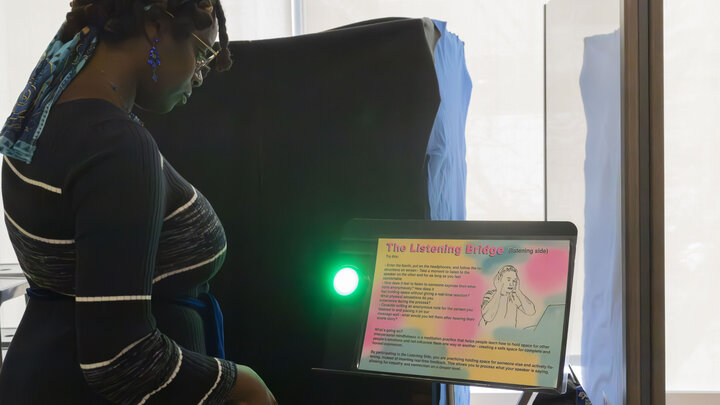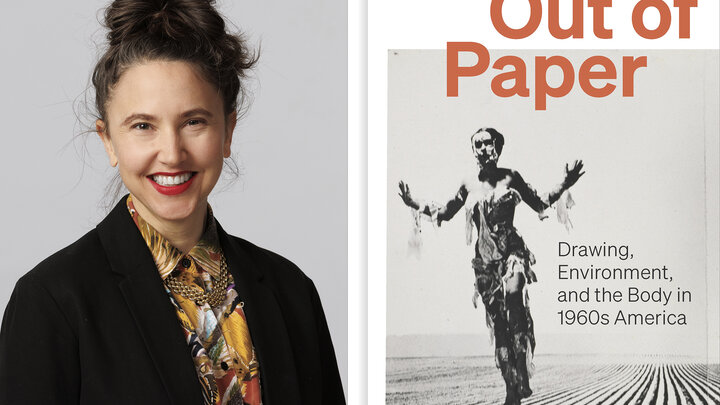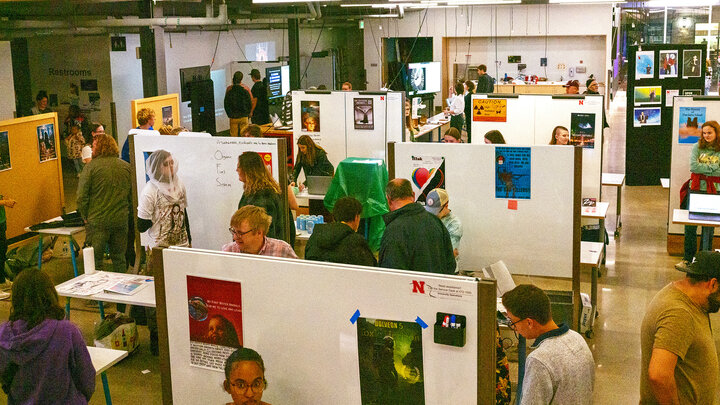Lincoln, Neb.--Students in Assistant Professor of Emerging Media Arts Jesse Fleming’s Innovation Studio course this fall created interactive science exhibit prototypes that examined and practiced the science of mindfulness meditation. The projects were displayed at the Open Studios event Dec. 13.
In addition to teaching mindfulness to the students for eight weeks, Fleming partnered with The Exploratorium, a museum of science, technology and the arts in San Francisco, California. They created a framework called “EDGE” (Exhibit Designs for Girls’ Engagement) that was designed to encourage girls to interact with science exhibits, which the emerging media arts students used in their projects. They met several times with Doug Thistlewolf, the new media developer at the Exploratorium.
“In a way, this class represented two foundational influences for me as a human being, including 23 years of mindfulness practice and then a decade of teaching mostly within art and design context,” Fleming said. “And then secondly, I grew up in the Bay Area and went to the Exploratorium. It was about 25 years between going and then taking our child to the museum, and I hadn’t realized how much it affected my trajectory and the way I think about artwork, so that was a hugely informative moment.”
The students also presented their final projects, which were the culmination of many prototypes, on Dec. 11, for two members of the programs staff at the Kiewit Luminarium, a similar museum in Omaha. Program Director Brent Gomez and Program Coordinator Alajia McKizia interacted with their exhibits and provided feedback for the students.
“Jesse Fleming’s students surprised my colleague and I,” Gomez said. “Their prototype exhibits surrounding the topic of Mindfulness were so impressive. The experiences that they constructed are the formative steps in creating agency in curiosity. Classes and work like this will change how we create and observe the world. This is the future. While sometimes the future looks bleak, work like this makes me optimistic, excited and happy to be in Nebraska.”
Abi Trembly, a senior emerging media arts major, was on a team that created “The Listening Bridge.”
“The Listening Bridge is a two-part experience based on interpersonal mindfulness,” she said. “In one half, users have the chance to anonymously speak about emotional experiences they may be going through. In the other half, users have the chance to sit and listen to those speakers and leave messages giving advice, encouragement or validation to those feelings. My group and I are hoping that people learn about active listening from this experience by being forced to wait to give a response until after the speaker has entirely finished.”
Edison Geiler, who also worked on The Listening Bridge, said it acted as a way for people to practice the concepts of mindful compassion.
“We hope the people who used it were able to have at least a moment of catharsis, that they had the opportunity to speak about what has been on their minds without judgement, and listen to others without judging them,” he said. “The Listening Bridge would hopefully act as a catalyst for people to start recognizing how we can be present for others and how others can be present for us.”
Geiler said the class’s focus on mindfulness will be useful in his daily life and in his future plans to direct and write films.
“The themes of mindfulness and mindful practice can translate really well to different mediums, especially as I am looking for ways for my art to connect and heal people,” he said. “Thinking about mindfulness is going to be really useful with how I approach telling stories in the future.”
Charlie Major, a senior emerging media arts major, was on the team that created “Stressed Out, Up and Down.”
“Stressed Out, Up and Down is an arcade-style game aiming to help people be more conscious of their stress,” he said. “Using a galvanic skin response sensor, you control a character to collect coins by raising and lowering your stress level. What our group is hoping people get from playing our game is that they will find ways to lower their stress and be more aware of how they can control it.”
He learned about the science behind mindfulness.
“It isn’t just a state of mind,” Major said. “There are actual physical responses our body makes when we are being mindful and meditative, which really helped give us a framework for what our project could be.”
The other two projects created were “The Waiting Room,” which recreated a waiting room experience and encouraged mindfulness during the waiting period, and “Sound Color,” where participants listened to sounds and colored how the sound made them feel.
Trembly said Gomez and McKizia from the Luminarium provided valuable feedback for their project.
“Mostly focusing on how to ensure it feels as private and comfortable as possible,” she said. “It was very helpful to have them there because they, of course, are professionals, but also they design within the EDGE framework as well at the Luminarium, so they had a lot of context about what sort of feel we were trying to achieve.”
Major said they seemed to enjoy the projects.
“Even though they saw the projects a couple of days before Open Studios, they still gave us good feedback that would greatly improve the project, especially if it were to continue,” he said.
Trembly said she learned a lot from the class.
“I think the two biggest ones are how to practice mindfulness and the EDGE framework,” she said. “I have created interactive experiences before, but this framework recontextualizes how I will design them in the future to be more inclusive to all kinds of people. The mindfulness practice is something I intend to keep doing in my day-to-day life. It genuinely really does help me slow down and break things down into a more manageable plan.”
She also said working in a team and learning from so many professionals will benefit her in the future.
“Those are skills that are beneficial for any kind of career and make us much more marketable and ready for the professional world,” she said.
She is glad she took the class.
“I feel really lucky to have been a part of this class this semester,” Trembly said. “The chance to speak with all kinds of professional connections and even be able to talk about the possibility to have my group’s work on the floor of the Luminarium is such an honor, and an opportunity that I might not have had without this class.”
Some of the Innovation Studio projects may end up on display at the Luminarium this spring. Gomez hopes the Luminarium can continue to partner with the Carson Center in the future.
“The Programs team from the Kiewit Luminarium is extremely excited to collaborate and partner with the Carson Center,” he said. “We believe this relationship has so much room to grow and evolve over time. The reciprocity between both organizations will benefit not only the institutions themselves, but also the Nebraska community in its entirety.”



